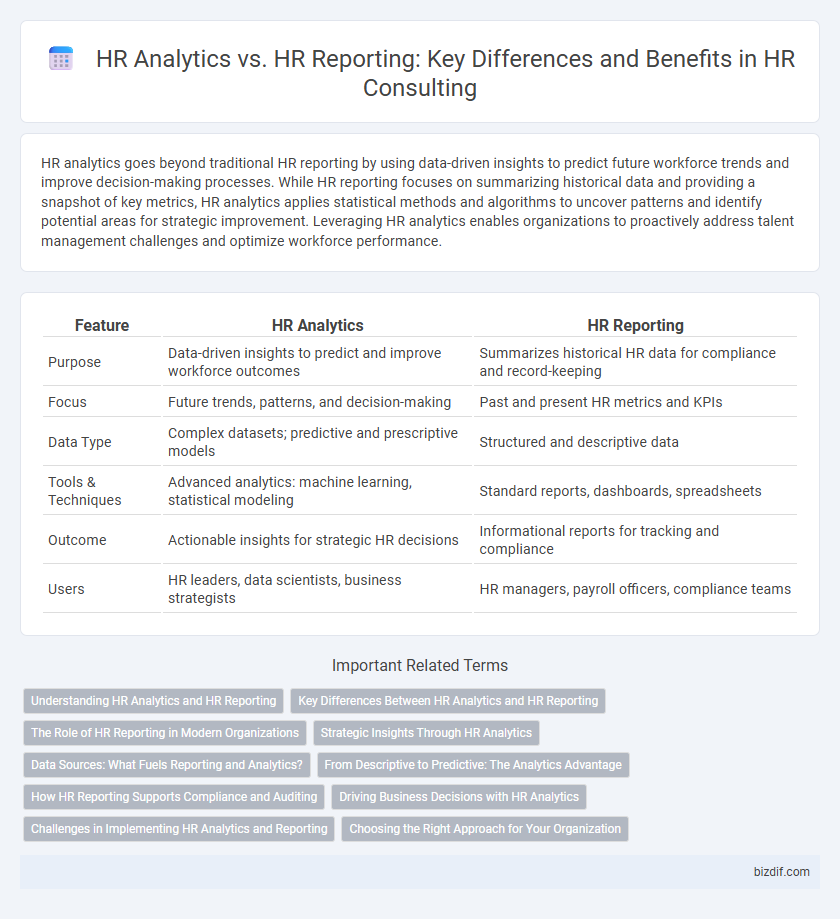HR analytics goes beyond traditional HR reporting by using data-driven insights to predict future workforce trends and improve decision-making processes. While HR reporting focuses on summarizing historical data and providing a snapshot of key metrics, HR analytics applies statistical methods and algorithms to uncover patterns and identify potential areas for strategic improvement. Leveraging HR analytics enables organizations to proactively address talent management challenges and optimize workforce performance.
Table of Comparison
| Feature | HR Analytics | HR Reporting |
|---|---|---|
| Purpose | Data-driven insights to predict and improve workforce outcomes | Summarizes historical HR data for compliance and record-keeping |
| Focus | Future trends, patterns, and decision-making | Past and present HR metrics and KPIs |
| Data Type | Complex datasets; predictive and prescriptive models | Structured and descriptive data |
| Tools & Techniques | Advanced analytics: machine learning, statistical modeling | Standard reports, dashboards, spreadsheets |
| Outcome | Actionable insights for strategic HR decisions | Informational reports for tracking and compliance |
| Users | HR leaders, data scientists, business strategists | HR managers, payroll officers, compliance teams |
Understanding HR Analytics and HR Reporting
HR analytics uses advanced data analysis techniques, including predictive modeling and machine learning, to uncover patterns and provide strategic insights that drive HR decision-making and improve workforce performance. In contrast, HR reporting involves the systematic collection and presentation of historical HR data, such as employee attendance, turnover rates, and payroll information, to support operational management and compliance. Understanding HR analytics and HR reporting enables organizations to balance real-time monitoring with forward-looking strategies for optimized human capital management.
Key Differences Between HR Analytics and HR Reporting
HR analytics involves using advanced data analysis techniques, such as predictive modeling and machine learning, to identify patterns and provide strategic insights for improving workforce performance and decision-making. HR reporting focuses on the systematic collection and presentation of historical employee data, like attendance, turnover rates, and payroll information, to generate regular reports for compliance and operational tracking. The key difference lies in HR analytics being forward-looking and decision-driven, while HR reporting is descriptive and retrospective.
The Role of HR Reporting in Modern Organizations
HR reporting provides organizations with essential data on workforce metrics such as employee turnover, attendance, and performance trends, enabling informed decision-making and regulatory compliance. Unlike HR analytics, which focuses on predictive insights and strategic planning, HR reporting ensures accurate tracking and communication of HR activities in real-time. Modern organizations rely on comprehensive HR reports to monitor operational efficiency, identify areas for improvement, and support evidence-based HR management.
Strategic Insights Through HR Analytics
HR analytics provides strategic insights by leveraging advanced data modeling and predictive techniques to uncover trends that traditional HR reporting cannot reveal. Unlike HR reporting, which primarily focuses on descriptive metrics and historical data, HR analytics enables organizations to forecast workforce needs, optimize talent management, and improve employee engagement through data-driven decision-making. Implementing HR analytics transforms raw data into actionable strategies that drive organizational performance and long-term business growth.
Data Sources: What Fuels Reporting and Analytics?
HR reporting relies primarily on structured data from payroll systems, attendance records, and employee databases to generate routine summaries and compliance reports. HR analytics integrates diverse data sources, including performance management systems, employee engagement surveys, and external market trends, enabling predictive insights and strategic workforce planning. Leveraging advanced analytics tools on multi-source data transforms raw information into actionable talent management decisions.
From Descriptive to Predictive: The Analytics Advantage
HR reporting primarily focuses on descriptive data, offering insights into past and current workforce metrics such as headcount, turnover rates, and employee demographics. HR analytics extends beyond reporting by leveraging predictive models and advanced statistical techniques to forecast future trends, optimize talent management, and enhance decision-making. This shift from descriptive to predictive analysis transforms HR functions into strategic drivers of organizational performance and agility.
How HR Reporting Supports Compliance and Auditing
HR reporting generates accurate and timely data on employee records, payroll, and labor law adherence, enabling organizations to meet regulatory compliance requirements effectively. Detailed HR reports provide audit trails that facilitate internal and external auditing processes, reducing risks of non-compliance and potential penalties. Leveraging HR reporting tools ensures documentation accuracy and transparency necessary for compliance monitoring and legal accountability in human resources management.
Driving Business Decisions with HR Analytics
HR analytics leverages advanced data modeling and predictive insights to inform strategic workforce planning, enhancing talent acquisition, retention, and productivity outcomes. In contrast, HR reporting provides historical data summaries and compliance tracking that support operational transparency but lack forward-looking guidance. By integrating HR analytics, organizations enable data-driven decision-making that directly aligns human capital management with broader business objectives, driving competitive advantage and operational efficiency.
Challenges in Implementing HR Analytics and Reporting
Implementing HR analytics and reporting presents challenges such as data quality issues, inadequate technology infrastructure, and limited employee skills in data analysis. Organizations often struggle with integrating disparate HR systems, resulting in inconsistent data that hampers accurate insights. Ensuring data privacy and compliance with regulations adds complexity to deploying effective HR analytics and reporting frameworks.
Choosing the Right Approach for Your Organization
HR analytics involves predictive modeling and deep data analysis to forecast workforce trends and drive strategic decisions, whereas HR reporting focuses on summarizing historical and current HR data for compliance and operational efficiency. Selecting the right approach depends on your organization's maturity in data capabilities, business objectives, and the need for actionable insights versus routine data monitoring. Organizations with advanced data infrastructure benefit from HR analytics to enhance talent management and organizational performance, while those emphasizing standard operational oversight may prioritize HR reporting.
HR analytics vs HR reporting Infographic

 bizdif.com
bizdif.com